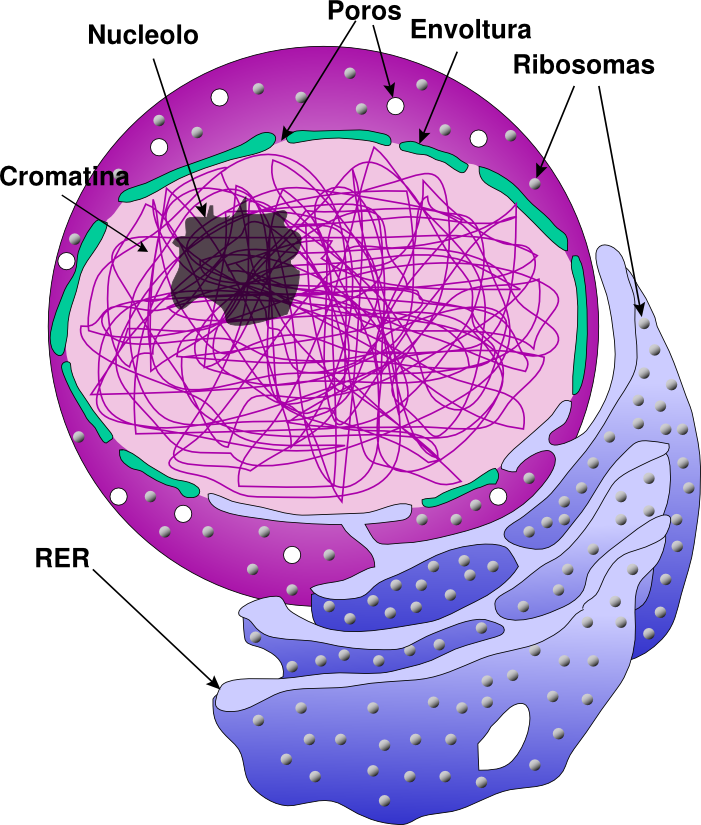The Nucleus: Command Center of the Cell
Imagine the cell as a miniature city. At the heart of this bustling metropolis lies the nucleus, the cell's command center. This vital organelle houses the precious DNA blueprint that guides all cellular activities. Let's explore the intricate structure and critical functions of the nucleus.
What Does the Nucleus Look Like?
- The Control Center: The nucleus is typically the largest and most prominent organelle within a eukaryotic cell (cells of animals, plants, fungi, and protists).
- Protective Envelope: It houses the cell's DNA safely within a double membrane called the nuclear envelope.
- Pores for Traffic: The nuclear envelope isn't a solid wall! It has nuclear pores that control the movement of molecules in and out of the nucleus.
- Chromatin and Nucleolus: Inside, you'll find a tangle of DNA called chromatin, and a dark region called the nucleolus, which produces ribosomes (the cell's protein factories).
The Essential Jobs of the Nucleus
- Safeguarding DNA: The nucleus acts as a secure vault, protecting the cell's precious genetic information from damage in the bustling cellular environment.
- Controlling Gene Expression: The nucleus determines which genes are turned "on" or "off," ensuring the cell produces the right proteins at the right time. This is essential for cell specialization and function.
- Cell Division Central: During cell division, the nucleus coordinates the replication and separation of chromosomes, allowing genetic information to be passed on accurately to new daughter cells.
- Ribosome Production: The nucleolus within the nucleus is the cell's ribosome factory. Ribosomes are essential for protein synthesis, the building blocks of cellular structures.
When Things Go Wrong: Nuclear Disorders
Disruptions within the nucleus can have dire consequences for the cell and the organism as a whole. Some examples of disorders related to nuclear malfunction include:
- Cancer: Mutations in genes that control cell division within the nucleus can lead to uncontrolled cell growth.
- Progeria: Defects in the structure of the nucleus cause rapid aging in this condition.
- Autoimmune diseases: Sometimes the immune system attacks components of the nucleus, leading to conditions like lupus.
The Nucleus: A Masterpiece of Biology
From its protective envelope to its role in cell division, the nucleus is a testament to the intricate organization of life's building blocks. Understanding its functions sheds light on development, disease, and the very essence of how our cells work.
FAQ: The Nucleus
Q: What's the difference between chromatin and chromosomes? A: Chromatin is the loose, thread-like form of DNA within the nucleus throughout most of the cell's life. Before the cell divides, the chromatin condenses tightly into the familiar X-shaped structures called chromosomes. This makes it easier for the cell to organize and divide the DNA accurately.
Q: If the nucleus controls the cell, what controls the nucleus? A: Great question! Even though the nucleus houses DNA, there are complex signaling pathways and feedback mechanisms within the cell and between cells that regulate what the nucleus does. Things like hormones, nutrients, and signals from neighboring cells can all influence the activity of genes within the nucleus.
Q: Do all cells have a nucleus? A: No! Mature red blood cells actually lose their nuclei to make more space for carrying oxygen. Also, prokaryotic cells (bacteria and archaea) don't have a true nucleus. Their DNA is in a region called the nucleoid, but it's not enclosed by a membrane.
Q: Can a cell survive without a nucleus? A: For a short time, maybe. A cell without a nucleus can't make new proteins or divide, which means it can't repair damage or grow. Eventually, it will likely die.
Q: Can a cell have more than one nucleus? A: Yes! Some specialized cells, like certain muscle cells, have multiple nuclei to better coordinate their activities and control their large size.


